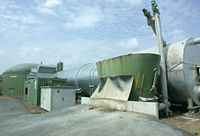
Photo from wikipedia
Abstract Hydrothermal liquefaction (HTL) is a promising technology for converting organic-rich waste biomass such as swine manure (SM) and sewage sludge (SS) into energy-dense bio-crude. Until now, one of the… Click to show full abstract
Abstract Hydrothermal liquefaction (HTL) is a promising technology for converting organic-rich waste biomass such as swine manure (SM) and sewage sludge (SS) into energy-dense bio-crude. Until now, one of the major challenges associated with HTL is the pumpability of high dry-matter containing fibrous feedstocks for continuous processing. In this context, this batch scale study presents a suitable approach for enhancing the pumpability of the fibrous material, specifically SM, by co-processing with SS. Obtained results showed that SM was not pumpable itself due to its fibrous nature, but became pumpable by the addition of SS at overall 25 % dry matter content. It was highlighted that the sample mixture containing ~80 % of the SM was smoothly pumped with 20 % SS. Subsequently, HTL experiments were carried out on samples mixed under the ratios SM:SS (100:0, 0:100, 50:50, 80:20, and 20:80). The highest bio-crude yield (42.38 %) via maximum synergistic effect was obtained from the sample SM/SS (50:50) at ratio 1:1 with the best HHV of 36 MJ/kg. Almost 60–70 % mass of all bio-crudes contained volatiles at 350 °C. ICP-AES measurements revealed that the majority of the inorganic elements were concentrated into the solid phase, while 40–50 % of the potassium and sodium were transferred to the aqueous phase. In conclusion, using SS as a co-substrate with SM not only enhances the pumpability of SM, but its co-liquefaction has demonstrated beneficial synergistic effects on improving the energy recovery of the bio-crude.
Journal Title: Fuel
Year Published: 2020
Link to full text (if available)
Share on Social Media: Sign Up to like & get
recommendations!